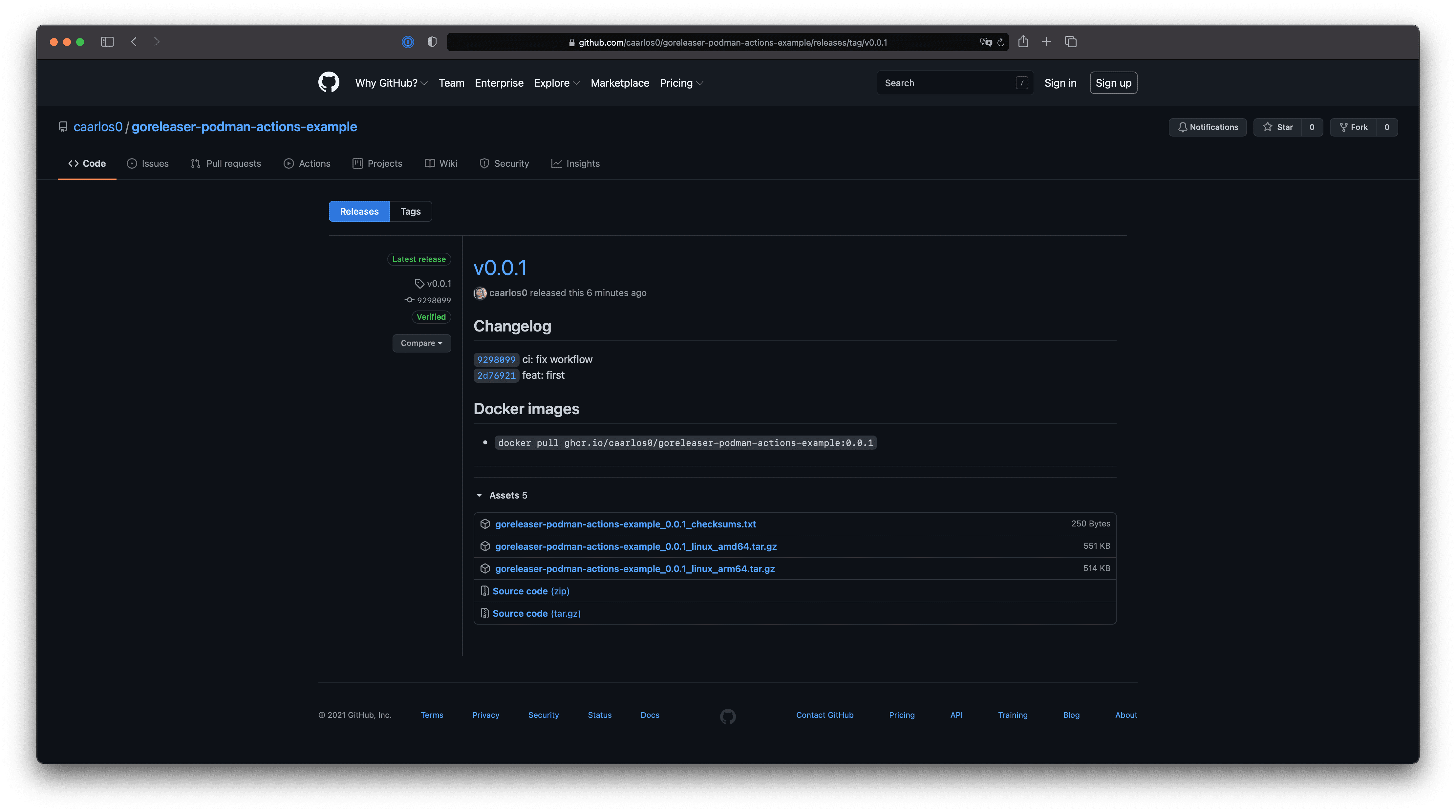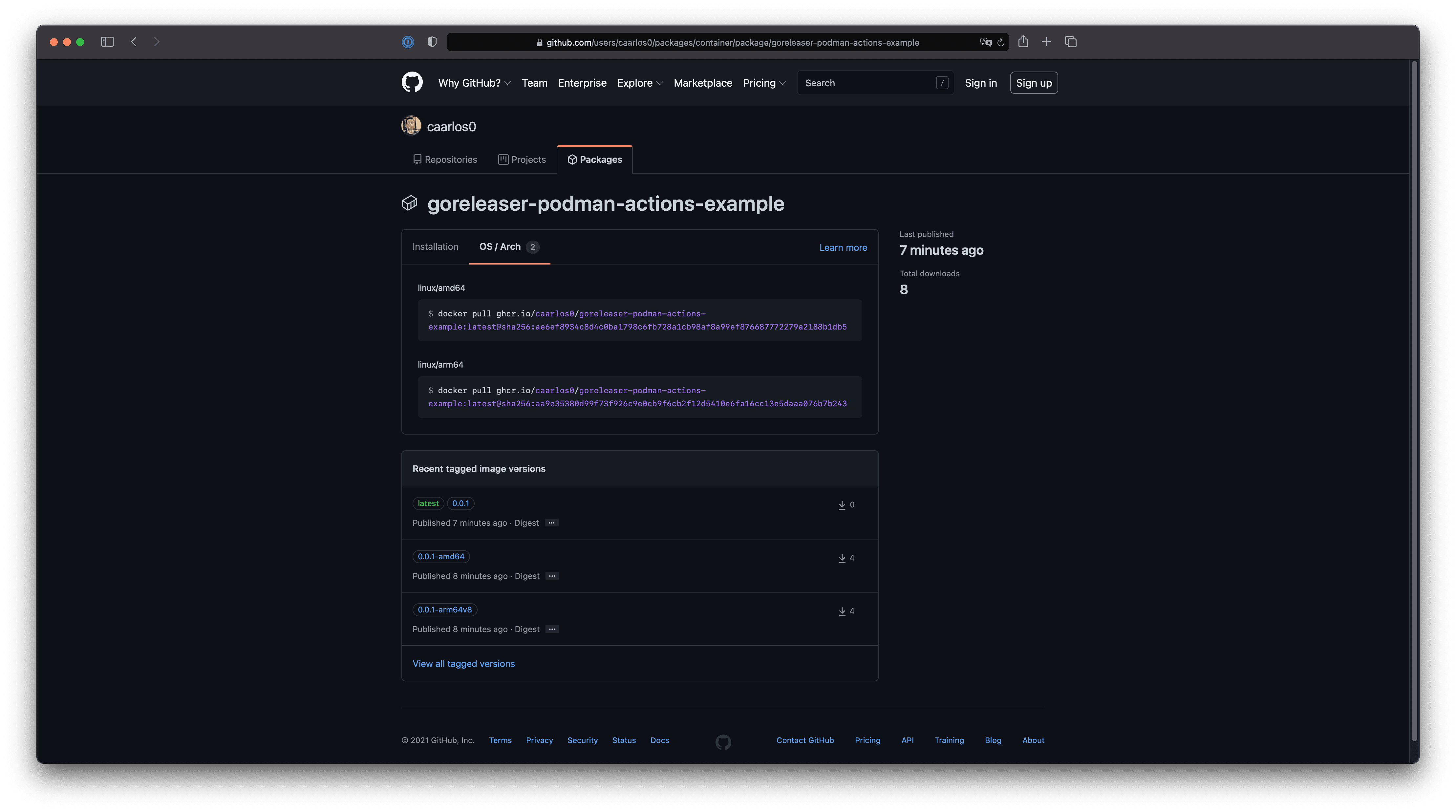Announcing GoReleaser v2.1
Winter is here (in the South America)! Let’s see whats new! Highlights new: before …
A few months ago, I published a post on Multi-platform Docker images with GoReleaser and GitHub Actions. Today’s post has the same idea, but using Podman instead of Docker.
The main advantage of Podman is that you can run in rootless mode (e.g. inside a container) and that it doesn’t require a daemon.
I created an example project showing with all the code needed for everything to work. You can check it out here.
main.goFor our example, we’ll have a very simple main.go file:
// main.go
package main
import (
"fmt"
"runtime"
)
var version = "dev"
func main() {
fmt.Println("example", version, runtime.GOOS, runtime.GOARCH)
}
DockerfileGoReleaser builds Docker images by copying the previously built binaries to the images (instead of building the binary inside Docker itself). This guarantees that the binary inside the image and the one you download from the releases page is the same.
Our very basic Dockerfile looks like this:
# Dockerfile
FROM alpine
COPY goreleaser-podman-actions-example /usr/bin/goreleaser-podman-actions-example
ENTRYPOINT ["/usr/bin/goreleaser-podman-actions-example"]
To account for multiple platforms, we either create several dockerfiles, or use the --platform build flag. We’ll use the second approach in our example.
We can test it without GoReleaser by running:
GOOS=linux GOARCH=amd64 go build .
podman build -t testimage:amd64 . --platform=linux/amd64
GOOS=linux GOARCH=arm64 go build .
podman build -t testimage:arm64v8 . --platform=linux/arm64/v8
With that in place, let’s check our GoReleaser config file.
.goreleaser.yml fileOur GoReleaser config file is very simple:
builds section which will build for multiple platforms;dockers section, building one image for amd64 and another for arm64, setting the use property to podman;docker_manifests section, tying together the two images in a single manifest and also setting the use property to podman.It looks like this:
# .goreleaser.yml
builds:
- env: [CGO_ENABLED=0]
goos:
- linux
- darwin
- windows
goarch:
- amd64
- arm64
dockers:
- image_templates: ["ghcr.io/caarlos0/{{ .ProjectName }}:{{ .Version }}-amd64"]
dockerfile: Dockerfile
use: podman
build_flag_templates:
- --platform=linux/amd64
- --label=org.opencontainers.image.title={{ .ProjectName }}
- --label=org.opencontainers.image.description={{ .ProjectName }}
- --label=org.opencontainers.image.url=https://github.com/caarlos0/{{ .ProjectName }}
- --label=org.opencontainers.image.source=https://github.com/caarlos0/{{ .ProjectName }}
- --label=org.opencontainers.image.version={{ .Version }}
- --label=org.opencontainers.image.created={{ time "2006-01-02T15:04:05Z07:00" }}
- --label=org.opencontainers.image.revision={{ .FullCommit }}
- --label=org.opencontainers.image.licenses=MIT
- image_templates: ["ghcr.io/caarlos0/{{ .ProjectName }}:{{ .Version }}-arm64v8"]
goarch: arm64
dockerfile: Dockerfile
use: podman
build_flag_templates:
- --platform=linux/arm64/v8
- --label=org.opencontainers.image.title={{ .ProjectName }}
- --label=org.opencontainers.image.description={{ .ProjectName }}
- --label=org.opencontainers.image.url=https://github.com/caarlos0/{{ .ProjectName }}
- --label=org.opencontainers.image.source=https://github.com/caarlos0/{{ .ProjectName }}
- --label=org.opencontainers.image.version={{ .Version }}
- --label=org.opencontainers.image.created={{ time "2006-01-02T15:04:05Z07:00" }}
- --label=org.opencontainers.image.revision={{ .FullCommit }}
- --label=org.opencontainers.image.licenses=MIT
docker_manifests:
- name_template: ghcr.io/caarlos0/{{ .ProjectName }}:{{ .Version }}
use: podman
image_templates:
- ghcr.io/caarlos0/{{ .ProjectName }}:{{ .Version }}-amd64
- ghcr.io/caarlos0/{{ .ProjectName }}:{{ .Version }}-arm64v8
- name_template: ghcr.io/caarlos0/{{ .ProjectName }}:latest
use: podman
image_templates:
- ghcr.io/caarlos0/{{ .ProjectName }}:{{ .Version }}-amd64
- ghcr.io/caarlos0/{{ .ProjectName }}:{{ .Version }}-arm64v8
You can check more options for builds, docker and docker manifests on GoReleaser’s website.
The labels added to the images are optional, but in the specific case of
ghcr.io, they allows GitHub to know which image is built from which repository and other metadata.
We can now verify this locally with:
goreleaser release --snapshot --clean
GoReleaser will use defaults for a lot of things, you can check the full config (with the defaults) in at dist/config.yaml.
Here we pretty much copy what’s already in GitHub Actions section in the GoReleaser’s website:
# .github/workflows/goreleaser.yml
name: goreleaser
on:
push:
tags:
- '*'
permissions:
contents: write
jobs:
goreleaser:
runs-on: ubuntu-latest
steps:
- name: Checkout
uses: actions/checkout@v2
with:
fetch-depth: 0
- name: Set up QEMU
uses: docker/setup-qemu-action@v1
- name: Log in to ghcr.io
uses: redhat-actions/podman-login@v1
with:
username: ${{ github.repository_owner }}
password: ${{ secrets.GH_PAT }}
registry: ghcr.io
- name: Set up Go
uses: actions/setup-go@v2
with:
go-version: 1.16
- name: Run GoReleaser
uses: goreleaser/goreleaser-action@v2
with:
distribution: goreleaser-pro
version: latest
args: release --clean
env:
GITHUB_TOKEN: ${{ secrets.GH_PAT }}
GORELEASER_KEY: ${{ secrets.GORELEASER_KEY }}
qemu in order to build Docker images in platforms other than linux/amd64 using podman build;GITHUB_TOKEN does not have enough permissions;GORELEASER_KEY.And that’s pretty much it!
Now, we just need to push a tag, sit back, relax and watch the GoReleaser Action do everything.
In the end, you should have a release more or less like this:

GitHub Release - the changelog, assets and our multi-platform Docker image
You should also be able to see that the image is in fact multi-platform in the container registry:

GitHub Container Registry showing both OS/Arch combinations we provided.
We can now run our image with either Docker or Podman:
$ docker run --rm --platform linux/amd64 \
ghcr.io/caarlos0/goreleaser-podman-actions-example
example 0.0.1 linux amd64
$ podman run --rm --platform linux/amd64 \
ghcr.io/caarlos0/goreleaser-podman-actions-example
example 0.0.1 linux amd64
We can also test the arm64 image:
$ docker run --rm --platform linux/arm64 \
ghcr.io/caarlos0/goreleaser-podman-actions-example
example 0.0.1 linux arm64
$ podman run --rm --platform linux/arm64 \
ghcr.io/caarlos0/goreleaser-podman-actions-example
example 0.0.1 linux arm64
It works! 🎉
That’s it! I hope this is useful somehow.
Don’t forget to check out GoReleaser’s documentation for more details. Also make sure to take a look at Docker’s manifest documentation.
Also check out the GoReleaser Pro offering!